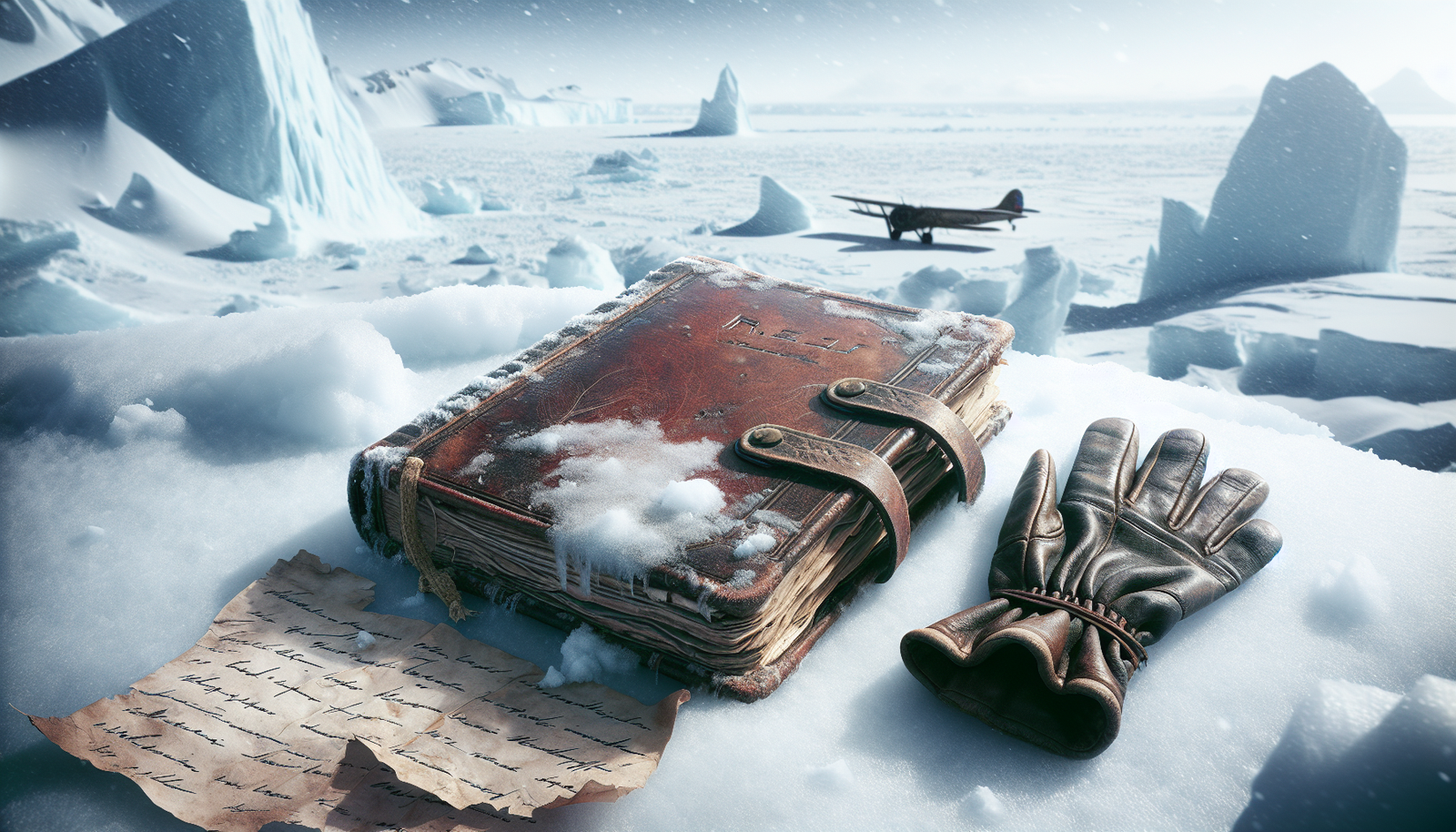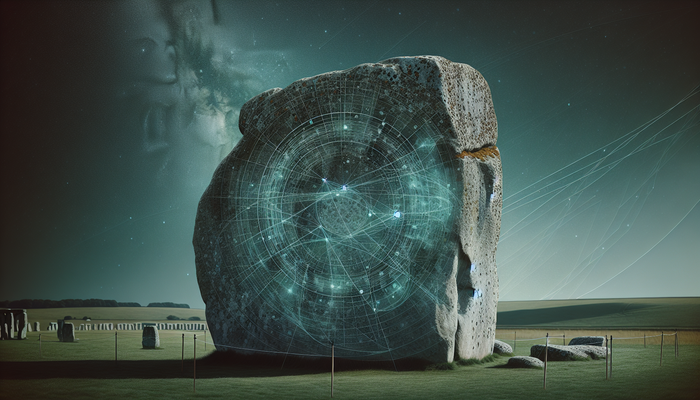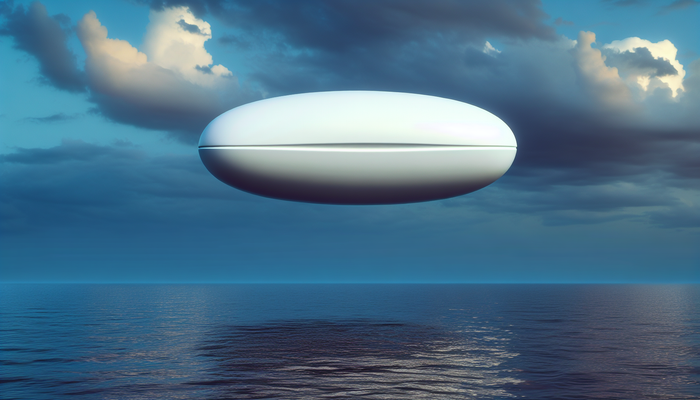Unpacking Operation Highjump Mysteries

By Gabriel Chen, Ufologist
: A Deep Dive into the Icy Enigmas
Introduction: The Coldest Case
Antarctica. Just the name conjures images of blinding white landscapes, otherworldly ice formations, and a silence so profound it rings in your ears. It’s the planet's final frontier, a continent wrapped in ice and isolation. But beyond the stunning desolation, Antarctica also serves as a vast, frozen canvas onto which we project our wildest imaginations, our deepest anxieties, and our most persistent questions about hidden truths. It’s the ultimate cold case file, a place where the gaps in our knowledge become breeding grounds for speculation. And few chapters in its history are as dense with intrigue as Operation Highjump.
Picture this: it’s 1946, the dust of World War II is still settling, and the United States Navy launches the largest expedition ever sent to the Antarctic. We’re not talking a handful of scientists and a couple of sturdy ships. Operation Highjump, officially the U.S. Navy Antarctic Developments Program, was a behemoth: 13 ships, including an aircraft carrier and a submarine, dozens of aircraft (reports vary between 23 and 33, a small mystery in itself), and a staggering force of over 4,000, possibly as many as 4,700, military personnel. Helmed by the celebrated polar explorer Admiral Richard E. Byrd, this armada steamed south into the icy unknown. Right away, the sheer scale raises a flag redder than any marker flag planted in the snow. Why deploy such immense military might, equipped for battle, to the bottom of the world for what was publicly billed as a mission of training and scientific discovery? That question is the icy portal through which we step into the labyrinth of Operation Highjump mysteries. It’s more than just a historical footnote; it’s a saga layered with official explanations, whispered rumors, alleged secret diaries, tales of hidden Nazi redoubts, and encounters with forces beyond our comprehension.
The Official Narrative: Surface Level Explanations
On the surface, the reasons for Operation Highjump seemed clear enough, rooted firmly in the geopolitical soil of 1946. World War II had reshaped the global stage, and the nascent chill of the Cold War was beginning to creep across the map. Polar regions, once seen as remote curiosities, were gaining strategic significance. If a future conflict erupted, controlling or understanding these icy gateways could be crucial.
Admiral Byrd himself laid out the mission's purposes: primarily military. The Navy needed to know how its men and machines would hold up in the planet’s most extreme cold. Could standard equipment function? Could personnel operate effectively? As Byrd stated, they aimed "to train naval personnel and to test ships, planes and equipment unter frigid zone conditions." Think of it as the ultimate cold-weather stress test, preparing for scenarios where polar operations might become necessary. Alongside this, there was the undeniable goal of planting the American flag firmly, consolidating and extending U.S. sovereignty "over the largest practical area of the Antarctic continent," even if this was often downplayed publicly.
Science wasn't entirely absent from the official docket, though it often seemed secondary to the military objectives. The mission planned to map vast, uncharted swathes of the coastline and interior – a monumental task in itself. They intended to conduct geological surveys, study the notoriously wild Antarctic weather patterns, and investigate potential locations for establishing permanent bases. Figures like Dr. Paul Siple, a veteran of previous Byrd expeditions and an expert in adapting to extreme environments, were involved, lending scientific credibility and applying his research towards national defense needs, advising on everything from clothing to survival.
To document this grand undertaking, military photographers were embedded within the task force. Their footage became the basis for the 1948 documentary film, "The Secret Land." Narrated by Hollywood stars like Robert Taylor and Robert Montgomery, the film showcased the dramatic landscapes, the operational challenges, and the perceived successes of the mission. It even won the Academy Award for Best Documentary Feature, cementing the official, public-facing image of Operation Highjump as a bold, albeit challenging, venture into the Antarctic wilderness. Yet, for all the official reports and Hollywood gloss, the sheer scale and military muscle involved left nagging questions unanswered, creating cracks in the icy facade through which alternative, more shadowed interpretations began to seep.
Mystery 1: The Shadow of the Swastika - Hunting a Hidden Nazi Base?
One of the most enduring and dramatic mysteries swirling around Operation Highjump involves the swastika's long shadow stretching even to the Antarctic ice. Could this massive naval operation have been a covert mission to hunt down a secret Nazi stronghold hidden at the bottom of the world? It sounds like pulp fiction, but like many persistent myths, it latches onto a few historical realities.
The Nazis did have Antarctic ambitions, however brief. In 1938-1939, the German Third Reich dispatched the expedition ship MS Schwabenland to the continent. Using seaplanes launched by catapult, they surveyed a vast area of Dronning Maud Land, dropping metal swastika flags to stake a claim they dubbed Neuschwabenland (New Swabia). Officially, the mission was about securing whaling grounds to reduce Germany's reliance on imported fats and oils, and perhaps scouting for a naval base. But given the Nazi regime's known fascination with the occult, ancient myths, and secret weapons, this Antarctic foray provided fertile ground for later, darker speculation.
The theory posits that Neuschwabenland wasn't just a claim, but the site of a secret base, established before or during the war, and maintained after Germany's defeat in 1945. This hidden sanctuary, sometimes imagined in geothermally heated ice caves, supposedly became a refuge for high-ranking Nazis, perhaps even Hitler himself, who had faked his death. Adding fuel to this fire was the dramatic arrival of two German U-boats, U-530 and U-977, at Mar del Plata, Argentina, in July and August 1945 – months after the war in Europe ended. Wild theories emerged: had these submarines ferried Nazi elite, advanced technology, or even Hitler's ashes to the Antarctic base before surrendering?
Within this narrative, Operation Highjump transforms from a training exercise into a heavily armed task force sent specifically to find and obliterate Base 211, the supposed Nazi fortress. The aircraft carrier, the destroyers, the submarine – they weren't just for testing; they were for a potential battle. And the story gets wilder. Some versions claim the Nazis, perhaps aided by contact with extraterrestrials or harnessing mythical energies like "Vril," had developed flying saucers (flugscheiben or rundflugzeug) and other superweapons. Operation Highjump, in these tellings, climaxed in actual combat between US forces and these technologically superior Nazi craft emerging from the ice or sea, forcing a hasty American retreat.
Now, let's bring in the cold, hard reality check. The logistical nightmare of establishing and maintaining a large, secret, technologically advanced base in Antarctica, especially during and immediately after a devastating war, is almost insurmountable. Supply lines would be impossibly long and vulnerable. Building large underground structures in an ice-free "oasis" (which don't really exist in the warm sense imagined) within the timeframe of the Schwabenland's short visit is dismissed by experts. Furthermore, despite decades of subsequent international scientific activity, including bases established within Neuschwabenland, and extensive satellite mapping, not a shred of credible evidence for such a wartime or post-war Nazi base has ever surfaced. The U-boat commanders and crews were thoroughly interrogated by Allied forces upon surrendering in Argentina; their accounts indicated they simply fled Europe post-surrender, taking the long route to a potentially sympathetic neutral country, a journey whose timeline matches their capabilities without needing a detour to Antarctica's impossible winter conditions. Claims of Special Air Service (SAS) raids on the base are also unfounded; the SAS unit referenced wasn't even active in that period or region.
Yet, the Nazi Antarctic base myth persists. Why? Perhaps it speaks to the unease surrounding the sheer evil and technological ambition of the Third Reich – a sense that they must have had secrets we still haven't uncovered. It taps into the enduring mystery of vanished Nazis and the allure of "wonder weapons." And Antarctica itself, vast, remote, and forbidding, remains the perfect blank space on the map to project such fears and fantasies. The historical seeds – the Schwabenland expedition, the U-boat arrivals – were just enough to allow this chilling narrative to take root and grow, intertwining itself inextricably with the story of Operation Highjump.
Mystery 2: Admiral Byrd's Alleged Secret Diary - Flights of Fancy or Forbidden Truths?
Admiral Richard E. Byrd. The name itself commands respect in the annals of exploration. Medal of Honor recipient, pioneering aviator, the first man credited with flying over both the North and South Poles. He was, by all accounts, a pragmatic and courageous leader, a true American hero. This very reputation makes the claims associated with his alleged "secret diary" all the more shocking and captivating. If this man reported seeing what the diary describes, could it possibly be true?
The story goes that decades after Byrd's death in 1957, a secret personal diary or flight log surfaced, purportedly discovered by his son. This document supposedly recounts an unbelievable flight Byrd undertook during Operation Highjump, dated February 19th, 1947 (though some versions place it over the Arctic, adding to the confusion). As Byrd flew deeper into the polar region, the narrative claims, his instruments went haywire. Instead of endless ice, he found himself flying over a lush, green valley, strangely warm, spotting forests on mountain slopes and even what appeared to be a living mammoth grazing below.
The account escalates dramatically. Byrd flies towards what looks like a city, shimmering with rainbow colours, seemingly constructed from crystal. Suddenly, strange, disc-shaped aircraft – radiating light and marked with a symbol resembling a swastika (sometimes interpreted differently) – appear alongside his plane. These craft, described in some sources as "flugalrads," allegedly take control of Byrd's aircraft through an unseen force, disabling his engines but guiding him gently to a landing. He's met by tall, blond-haired beings and escorted via a levitating platform into the city, deep underground.
There, in a scene reminiscent of science fiction, Byrd is supposedly brought before a figure known as "the Master." This entity, representing an advanced inner-Earth civilization (sometimes called the "Ariani"), welcomes Byrd and explains their concern about surface humanity's recent discovery and use of atomic power, referencing the devastating bombings of Hiroshima and Nagasaki. They convey a warning about Earth's destructive path and express hope for humanity's future, implying they monitor surface events but are reluctant to interfere directly unless necessary.
After this incredible encounter, the diary claims, Byrd was escorted back to his plane, control was returned, and he flew back to base. However, upon reporting his experience to his superiors, including President Truman, he was allegedly ordered, in the name of national security and humanity itself, to remain completely silent. His official logs were confiscated, but this secret diary remained, holding the forbidden truth.
This narrative is pure catnip for proponents of certain fringe theories. It dovetails perfectly with the Hollow Earth hypothesis – the idea that our planet is hollow, potentially housing an internal sun and advanced civilizations in subterranean realms like the mythical Agartha or Shambhala. In this view, Antarctica holds one of the secret entrances, and Byrd stumbled into it. The timing, right after the first atomic bombs and at the dawn of the modern UFO era (often linked to Kenneth Arnold's sighting later in 1947), seems significant. The alleged beings' concern about nuclear weapons resonates with later accounts from UFO witnesses and even some military personnel reporting UFO interference at nuclear sites.
However, the authenticity of this "secret diary" is overwhelmingly rejected by mainstream historians and Byrd scholars. Strong evidence points towards it being a fabrication. The book most often associated with it, The Missing Diary of Admiral Richard E. Byrd, was penned not by Byrd, but by Walter Siegmeister, writing under the pseudonym Raymond Bernard, a well-known proponent of Hollow Earth and UFO theories. Critics point to numerous inconsistencies: the geographical confusion between the North and South Poles, log entries that seem lifted or modified from Byrd's actual, published logs, and passages from the "Master's" speech that bear striking resemblance to dialogue from the 1937 film Lost Horizon. Even the writing style, often laden with exclamation points, feels jarringly different from Byrd's known formal and reserved tone.
Despite the compelling evidence debunking it, the tale of Byrd's secret flight remains a cornerstone of the Operation Highjump mythology. Perhaps its power lies in its fulfillment of a deep-seated desire for wonder, for proof that there are realities beyond our mundane understanding, hidden worlds, and advanced beings watching over us. It transforms Byrd from a mere explorer into a cosmic messenger, and Operation Highjump from a military exercise into a potential first contact scenario, forever altering its significance in the eyes of believers. The "secret diary" may be fiction, but its impact on the narrative surrounding Operation Highjump is undeniably real.
Mystery 3: The Abrupt End - Weather or Something More Sinister?
One undisputed fact about Operation Highjump fuels endless speculation: it ended early. Way early. Planned as a lengthy six-to-eight-month deployment, the main operational phase in Antarctica wrapped up by late February 1947. The ships were heading north after only about six weeks on station near the main base, Little America IV. Why pull the plug on such a massive, expensive, and strategically important mission so prematurely?
The official Navy explanation was simple and, on the face of it, perfectly plausible: the weather. Antarctica is notoriously brutal, especially as the brief summer fades towards the unforgiving winter. The expedition faced extreme cold, violent storms (katabatic winds screaming off the polar plateau), and treacherous sea ice. Indeed, the operation wasn't without tragedy; several aircraft crashed during the mission, resulting in fatalities. The official documentary, "The Secret Land," vividly portrays some of these hardships, re-enacting damage control efforts and perilous flight conditions. Given these realities, pulling out before the worst of the winter locked the ships in ice seems like prudent seamanship.
But for those already primed to see shadows and secrets, the "bad weather" explanation felt too convenient, almost dismissive, for an operation of this magnitude. Could the U.S. Navy, with its resources, purpose-built icebreakers (though only one, the USCGC Northwind, was initially available, with the USS Burton Island arriving late), and seasoned commander, truly be sent packing solely by a harsh Antarctic summer turning foul? This skepticism opened the door for more dramatic interpretations.
Enter the "chased away" theory. If Highjump's real mission was to confront a hidden Nazi base or unknown forces, perhaps they encountered resistance far fiercer than anticipated. Eyewitness accounts, seemingly corroborated by later leaked documents (often of dubious origin, like alleged Soviet intelligence reports), speak of strange, aggressive flying craft emerging from the sea or sky, engaging the task force. Tales circulate of US planes being destroyed by mysterious energy beams, ships being attacked, and the Navy being forced into a humiliating retreat by superior technology. In this scenario, the early withdrawal wasn't about avoiding storms; it was about surviving an unexpected battle against an unknown enemy.
However, digging deeper into the operational realities offers compelling counterarguments without resorting to hostile flying saucers. The expedition did get off to a late start, arriving in the Ross Sea in mid-January, already significantly into the short Antarctic summer season. Many of the personnel, including pilots, lacked prior polar experience, making operations inherently riskier. While the icebreakers were capable, many of the other ships, including the supply vessels and even the destroyers, were standard steel-hulled ships, vulnerable to being damaged or trapped by the rapidly forming sea ice as winter approached. Professor Kenneth Bertrand noted the lack of polar experience among the vast majority of the personnel, especially the flyers. Flying itself was incredibly hazardous, with limited navigation aids, no established airfields beyond their own makeshift one, and the constant threat of "whiteout" conditions. Add the known logistical difficulties and the documented accidents, and the decision to withdraw before conditions became truly impossible seems less mysterious and more like a calculated decision based on risk assessment and the already achieved objectives (significant mapping had been done). The official explanation, while perhaps less thrilling, aligns well with the known dangers and limitations of operating such a large force in the world's harshest environment on a compressed timeline.
Mystery 4: Whispers in the Press - Byrd's Cryptic Comments
Adding another layer of intrigue to the Highjump saga are the comments attributed to Admiral Byrd himself during a stopover in Chile on the voyage home. In March 1947, he reportedly gave an interview to Lee van Atta of the International News Service, which was published in the Santiago newspaper El Mercurio. It's these translated remarks that have become iconic within the Highjump conspiracy literature.
According to widely circulated translations, Byrd issued stark warnings. He was quoted as saying it was "imperative for the United States to initiate immediate defense measures against hostile regions." More pointedly, he supposedly stated that he didn't want to "frighten anyone unduly," but it was a "bitter reality that in the case of a new war the continental United States would be attacked by flying objects which could fly from pole to pole at incredible speeds."
For those suspecting a cover-up, these words were dynamite. "Hostile regions" near Antarctica? "Flying objects" attacking from pole to pole at "incredible speeds"? This sounded like a direct reference to the advanced (Nazi or alien) craft supposedly encountered during the expedition. Byrd, the respected admiral, seemed to be trying to sound an alarm, hinting at a terrifying new threat he had witnessed firsthand, perhaps before being silenced by his government. His statements became Exhibit A in the case for a secret battle or extraordinary discovery during Operation Highjump.
However, like the secret diary, the context and accuracy of these translated quotes are fiercely debated. Researchers Colin Summerhayes and Peter Beeching, in their detailed analysis published in Polar Record, argue convincingly that the nuances were lost, and perhaps deliberately sensationalized, in translation and subsequent retelling. Examining the geopolitical context and Byrd's known concerns, a more grounded interpretation emerges. Byrd was likely speaking strategically about the future of warfare in the dawning air age and the Cold War. The polar regions offered the most direct routes between potential adversaries (like the US and the Soviet Union). The development of long-range bombers and, soon, jet aircraft and missiles meant that attacks could indeed come "from pole to pole at incredible speeds." His call for "defense measures" was likely aimed at establishing U.S. preparedness and potentially asserting control over these strategic polar approaches, not reacting to an existing fleet of Antarctic UFOs. The "flying objects" were probably a reference to foreseeable enemy aircraft and missiles, not alien discs. Paul Siple, who was on the expedition, later commented that reporters aboard the USS Mount Olympus had a tendency to "overblow" claims.
Despite this plausible, less sensational interpretation, the dramatic phrasing of the El Mercurio quotes took on a life of its own. They provided what seemed like confirmation, straight from the admiral's mouth, that something extraordinary and threatening had occurred. And when Admiral Byrd, upon returning to Washington D.C., was thoroughly debriefed and subsequently did refrain from making further public statements about the mission's more controversial aspects, it only cemented the belief for many that he had seen something profound and had been ordered into silence, validating the most extreme interpretations of his Chilean remarks.
Wider Antarctic Enigmas: Echoes of Highjump Mysteries?
The mysteries surrounding Operation Highjump don't exist in a vacuum. They are part of a much larger tapestry of strange tales, unexplained phenomena, and conspiracy theories woven around the Antarctic continent. It's almost as if the sheer emptiness and extremity of the place invite us to fill the void with the extraordinary. Sometimes, these other Antarctic enigmas become loosely tangled with the Highjump narrative, reinforcing the idea that the continent itself holds profound secrets that Byrd's expedition may have only glimpsed.
Consider the Wilkes Land Anomaly. Deep beneath the ice sheet in East Antarctica lies a massive gravitational anomaly, first detected in the 1950s. Scientific consensus leans towards it being a colossal impact crater, possibly linked to the Permian-Triassic extinction event – the "Great Dying." However, its sheer scale and hidden nature have made it a target for speculation. Could it be a crashed mothership? The ruins of an ancient, buried city? While not directly tied to Highjump chronologically, the idea of massive, hidden structures beneath the ice sometimes gets retroactively linked to the kinds of secrets Highjump might have been trying to find or cover up.
Then there's Lake Vostok, the largest of Antarctica's hundreds of subglacial lakes, buried under more than two miles of ice and isolated from the surface world for potentially millions of years. The eventual drilling into the lake and discovery of microbial life was a major scientific achievement. But naturally, it sparked wilder stories – rumors of encounters with bizarre, deadly creatures like the mythical shape-shifting octopus dubbed "Organism 46-B," supposedly captured and weaponized. While clearly fictional (originating from a known tabloid writer), these tales tap into the same vein of thought: that ancient, unknown, possibly dangerous things lurk beneath the ice, realms that Highjump might have inadvertently disturbed.
Even simple geology gets swept up in the mystery-making. Satellite imagery has revealed numerous sharp, angular mountain peaks poking through the ice, particularly in ranges like the Ellsworth Mountains. Some of these peaks, due to natural erosion patterns, coincidentally resemble pyramids. This has led to persistent internet theories about artificial structures, remnants of lost civilizations like Atlantis, or even alien bases. While geologists patiently explain these are natural formations called nunataks, the "Antarctic pyramids" meme keeps resurfacing, adding to the general sense that man-made (or alien-made) secrets are hiding in plain sight, secrets perhaps known since Highjump.
Add to this scattered reports over the decades from personnel stationed in Antarctica – pilots reporting anomalous lights or fast-moving silver discs, ground crews finding strange artifacts, tales of giant holes in the ice leading downwards – and you build a cumulative picture. While each incident might have a mundane explanation or be poorly documented, collectively they contribute to the feeling that something unusual is going on down there, something governments might be aware of, perhaps since the days of Operation Highjump. These separate strands of Antarctic mystery often become interwoven, creating a richer, more complex web of intrigue surrounding the continent and Byrd's infamous expedition.
Deconstructing the Narrative: Skepticism and Critical Analysis
When navigating the icy waters of Operation Highjump's mysteries, it’s crucial to keep a firm hand on the tiller of critical thinking. Separating documented historical facts from embellishments, misinterpretations, and outright fabrications is key. The allure of a grand conspiracy is powerful, but it often rests on shaky foundations.
Why do these stories – the Nazi base, the secret diary, the UFO battle – persist so strongly, despite lacking verifiable proof? Antarctica itself plays a role. Its remoteness, its alien landscape, its sheer unknown vastness make it a perfect screen onto which we can project our fascination with the hidden, the technologically advanced, and the potentially threatening. The post-World War II era was also a time of heightened anxiety about secret weapons, escaped enemies, and the dawn of the unsettling nuclear age and UFO phenomenon. These cultural currents provided fertile ground for such narratives to sprout and flourish.
We've seen how details can become twisted. Byrd's likely strategic warnings about future air power morph into eyewitness accounts of battling flying saucers. A brief, pre-war German expedition focused on whale oil becomes the staging ground for a vast, secret underground Reich. Isolated U-boat surrenders in Argentina become proof of a Nazi exodus to the pole. Exaggeration and misinterpretation, passed down and amplified over decades, build layers upon the original events until the myth obscures the reality. It’s a global game of telephone played across generations.
Crucially, for all the sensational claims, tangible evidence remains elusive. No wreckage of Nazi UFOs, no undisputed artifacts from an inner-Earth civilization, no credible, corroborated testimony of battles has emerged from the ice. What we have are stories, interpretations of ambiguous events, and documents often revealed to be hoaxes or misattributed. Absence of evidence isn't evidence of absence, the saying goes, but in this case, the complete lack of concrete proof for such extraordinary claims, despite decades of subsequent activity by multiple nations in Antarctica, weighs heavily against them.
Even the Antarctic Treaty of 1959, which reserves the continent for peaceful scientific purposes and prohibits military activity, gets drawn into the conspiracy web. Some theorists see it not as a landmark agreement for international cooperation and environmental protection, but as a sophisticated mechanism orchestrated by world powers to keep the public out and hide the secrets – whether Nazi, alien, or otherwise – discovered during Highjump or before. The reality, however, supported by decades of international scientific collaboration, points towards a genuine effort to preserve the continent and prevent it from becoming another Cold War battleground.
Still, acknowledging the lack of evidence for the wilder theories doesn't mean Antarctica holds no more secrets. It absolutely does – secrets locked in ice cores about past climates, secrets hidden in subglacial lakes about the limits of life, secrets buried in the rock about Earth's geological history. The continent remains largely unexplored beneath its icy mantle. This genuine unknown, this vast potential for real scientific discovery, perhaps ironically, ensures that speculation about more fantastical hidden truths will likely continue for as long as the ice remains.
The Enduring Legacy of Operation Highjump Mysteries
Decades after the last ships of Task Force 68 turned north, Operation Highjump remains more than just a footnote in naval history or Antarctic exploration. It stands as a truly captivating historical puzzle, a point where documented events, the personality of a famous explorer, the anxieties of an era, and the powerful allure of the unknown converged. The cocktail of a massive military force, a remote and forbidding location, alleged secret diaries, cryptic warnings, and rumors of Nazis and UFOs has proven irresistible.
Whether you see it as a straightforward military training exercise hampered by weather, a covert mission against hidden enemies, or a brush with the truly extraordinary, the story has undeniably embedded itself in our collective imagination. It has inspired countless books, documentaries (both factual and highly speculative), novels, films, and video games, ensuring that the questions surrounding Admiral Byrd and his Antarctic armada continue to echo in popular culture. And while shrouded in mystery, the expedition itself did contribute significantly to knowledge of Antarctica, mapping huge areas and providing valuable data that paved the way for future scientific endeavors, ultimately leading towards the international cooperation enshrined in the Antarctic Treaty.
Perhaps the most enduring legacy of the Operation Highjump mysteries is what they reveal about us. They reflect our deep-seated curiosity about the unexplored corners of our world and beyond. They tap into our fascination with conspiracy, our suspicion of official narratives, and our willingness, sometimes eagerness, to believe in possibilities that stretch the boundaries of known reality – hidden civilizations, extraterrestrial visitors, lost technologies. Even when faced with skepticism and debunking, the stories persist because they speak to that part of the human spirit that yearns for wonder, for secrets waiting to be found.
So, what really happened during those few weeks in the Antarctic summer of 1946-1947? Was it merely logistical challenges and bad weather that sent the fleet home early? Did Byrd witness something more profound than ice and penguins? Were there shadows of a defeated Reich lurking in the frozen wastes? The ice holds its secrets tightly. While we can analyze the facts, debunk the hoaxes, and understand the context, the complete, unambiguous truth behind all the layers of the Operation Highjump story may remain forever just beyond our reach, lost somewhere in the vast, white silence at the bottom of the world.
From Bigfoot to UFOs: Hangar 1 Publishing Has You Covered!
Explore Untold Stories: Venture into the world of UFOs, cryptids, Bigfoot, and beyond. Every story is a journey into the extraordinary.
Immersive Book Technology: Experience real videos, sights, and sounds within our books. Its not just reading; its an adventure.


























